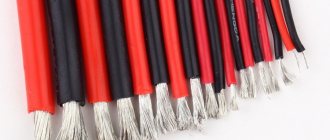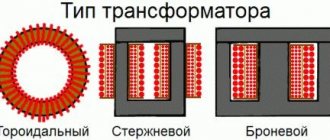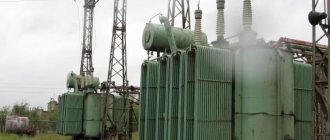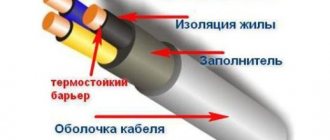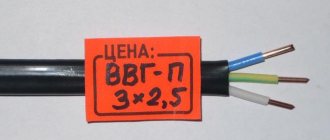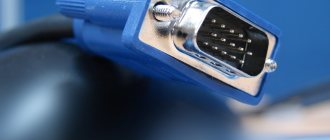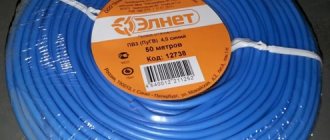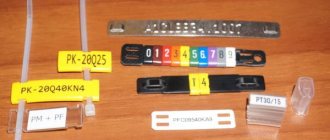When designing the installation of a particular equipment, various initial data are used, including technical characteristics. In this case, the marking of electric motors, displayed on a plate attached to the housing, becomes of great importance. The values of rated shaft power, rated voltage, winding connection diagram and current strength for each of them are indicated here. Other parameters include rated speed, power and efficiency factors, current frequency, insulation class, motor weight and others.
Designation of asynchronous electric motors
Let’s say the nameplate says AO2-62-4. The first two letters (or letter) are the execution of the engine:
- A – splash-proof.
- AO – closed ventilated.
The number following the letters means the series number (in our case 2). The two-digit number after the first dash is the standard size (6 is the outer core of the stator diameter, 2 is the length; both designations are conventional). The number after the second dash indicates the number of poles. That is, in our case we are dealing with a four-pole asynchronous three-phase motor of the second series in a closed, ventilated design, of the second length, of the sixth size.
Machines from 1 to 5 sizes of this series are considered more reliable and durable than engines in a protected design. A number of modified models are manufactured based on engines of the A, A2, AO and AO2 series. A 2nd (or 3rd) letter is added to their markings:
- P – overestimated starting torque.
- C – increased slip.
- K – model with a wound rotor.
- T – for use in the textile industry.
- L – shields and body are made of duralumin alloy.
General purpose motors with a duralumin stator winding are designated by the letter A after the last digit. The numbers divided by oblique lines (12/8/6/4) show the number of poles if the unit is designed for several speeds.
The following designations for asynchronous electric motors are also possible: 4AN280M2UZ. Deciphering the markings in order, we get the following:
- Series number – 4.
- Motor type – asynchronous protected – AN. If there is no letter H, the engine is a closed, ventilated design.
- The height of the rotation axis is 280 (it can be indicated by two numbers).
- The installation dimension along the length of the bed is M (S and L are possible).
- Number of poles – 2.
- Climatic version - U.
- Accommodation category – 3 (digital).
The letters A or X after the first A (AA or AX) indicate duralumin panels and a frame in the first case, and cast iron panels and a duralumin frame in the second. The letter K in the fourth position (4ANK) marks motors with a wound rotor.
The stator core can be of different lengths with unchanged frame dimensions. The sign A denotes the shortest, and the sign B the greatest length of the core. These letters are placed after the rotation height marking.
Modern marking of electric motors
There are several points that are usually displayed in standard markings:
- brand or type of equipment;
- peculiarities;
- useful shaft length;
- installation dimensions;
- core length;
- number of poles;
- modification;
- What climate is it designed for?
Below is a possible decoding of the designations:
For asynchronous motors the picture will look like this:
Indications of dust and moisture protection (according to the IP standard) are possible, where the first number indicates protection against dust, and the second – against water. Both values are from 0 to 8.
Installation specifications are required. That is, the electric motor is mounted on feet or using flanges, how the shaft needs to be oriented, etc.
If the letter B appears at the beginning of the marking, this means explosion-proof design.
In this case, the set of accompanying documents must include a certificate indicating the protection class, its type and scope of application.
In such a situation, the labeling standard may change and take the following form:
Traction crane electric motors have their own designation system.
Here is an example of a plate for an asynchronous electric machine.
The analysis confirms the following:
- AIR – asyn type. cars;
- 80 – shaft overhang;
- A – installation dimensions;
- 4 – number of pairs of poles;
- U – version for temperate latitudes;
- 3 – intended for indoor use.
Power 1.1 kW, rotation speed 1420 rpm. Depending on the method of switching the windings, the supply voltage is 220 or 380 V.
Current consumption depending on the supply voltage is 4.9/2.8A. IP54 is the degree of protection, the manufacturer is the Republic of Belarus.
The motor is connected through a terminal box (BRNO box). It contains windings on a dielectric panel.
Accordingly, we see the old and now accepted designations. By combining, you can switch the windings with a triangle or a star.
By connecting U1, V1, W1 (beginnings) we get a star, and using the sequence U1 with W2, V1 with U2, W1 with V2 - a triangle.
Engine marking according to climatic design
There is a generally accepted marking of the climatic performance of the engine:
- Temperate climate - U.
- Cool climate - HL.
- Humid tropical climate - TV.
- Dry tropical climate - TC.
- Tropical climates of both types - T.
- General climatic design (any land area) – O.
- Cool temperate maritime climate - M.
- Marine tropical climate - TM.
- Unlimited navigation area - OM.
- Any areas at sea and on land - V.
Electric motors
In engines of the A, AO, A2, AO2 and A3 series, the letter A means splash-proof, AO means closed, blown, the first number after the letters ? is the series number. The number after the first hyphen characterizes the standard size; the first digit in it indicates the size (conventional number of the outer diameter of the stator core), the second - conventional number of the length. The number after the second hyphen corresponds to the number of poles. For example, AO2-62-4 is an asynchronous three-phase electric motor in a closed, ventilated design, the second single series, the sixth size, the second length, four-pole. Electric motors of sizes 1–5 in the second series are produced only in a closed, ventilated design, which increases their reliability: the service life of a closed low-power machine increases by 1.5–2 times compared to a protected one.
Motors of the single series A, AO and A2, AO2 of the basic design have a squirrel-cage rotor with a cast aluminum winding. A number of engine modifications were created on their basis. When designating modifications, a letter for electric motors is added to the letter part: with increased starting torque - P (for example, AOP2-62-4); with increased slip - C, for the textile industry - T, with a wound rotor - K.
Asynchronous motors with increased starting torque are designed to drive mechanisms with heavy loads during the start-up period. Motors with increased slip are used for mechanisms with an uneven shock load and mechanisms with a high frequency of starts and reverses.
For general purpose motors with an aluminum stator winding, the letter A is added at the end of the designation (for example, AO2-42-4A). In motors with several rotation speeds, the figures characterizing the number of poles include all their values, separated by oblique lines: for example, AO-94-12/8/6/4 is a three-phase asynchronous motor of the AO series of 9 dimensions, 4th length by 12, 8, 6 and 4 poles.
The letter L (for example, AOL2-21-6) means that the body and shields are cast from aluminum alloy.
The designation of the standard size of a 4A series motor, for example 4AN280M2UZ, is deciphered as follows: 4 - serial number of the series, A - type of motor (asynchronous), N - protected (the absence of this sign means a closed ventilated design), 280 - height of the axis of rotation (three or two digits ), mm, S, M or L - installation dimension along the length of the frame, 2 (or 4, 6, 8, 10, 12) - number of poles, UZ - climatic version (U) and placement category (3).
After the first letter A there may be a second A (for example, 4AA63), which means that the frame and shields are made of aluminum alloy, or X—aluminum frame, cast iron shields; the absence of these signs indicates that the frame and shields are cast iron or steel.
The letter K is used in the designation of wound-rotor motors, for example 4ANK.
With the same frame dimensions, the stator core can have different lengths. In this case, in the size designation after the letters S, M, JL and immediately after the height of rotation, if these letters are absent, the signs A (shorter core length) or B (longer length) are placed, for example 4A90LA8, 4A90LB8, 4A71A6, 4A71B6.
Climatic versions of engines are designated by the following letters: U - for temperate climates, HL - for cold climates, TV - for humid tropical climates, TS - for tropical dry climates, T - for tropical both dry and wet climates, O - for all areas on land (general climate version), M - for a marine temperate cold climate, TM - for a tropical marine climate, . OM - for an unlimited navigation area, B - for all areas on land and sea.
Placement categories are indicated by numbers: 1 - for work outdoors, 2 - for rooms with relatively free access of air, 3 - for indoor spaces, where fluctuations in temperature, humidity, as well as exposure to sand and dust are significantly less than in the open air, 4 - for rooms with artificially controlled climatic conditions (for example, closed heated and ventilated industrial premises), 5 - for work in rooms with high humidity (for example, unventilated and unheated underground rooms, rooms in which there is a possibility of prolonged presence of water or frequent condensation of moisture on walls and ceiling).
GOST 17494-72 for electrical machines establishes the degree of protection of personnel from contact with live or moving parts located inside the machine and, in addition, from the ingress of solid foreign bodies and water.
Electric motors for general use are mainly manufactured in two degrees of protection: 1P23 (or IP22 for DC motors) and IP44: the first of them characterizes machines in a protected design, the second - in a closed version.
The alphanumeric designation of the degree of protection consists of the Latin letters IP and two numbers. The first of these numbers characterizes the degree of protection of personnel from contact with live and rotating parts located inside the machine, as well as the degree of protection of the machine itself from the ingress of solid foreign bodies into it; the second digit indicates the penetration of water into the machine.
In the designation 1P23, the first digit 2 indicates that the machine is protected against possible contact of human fingers with live and moving parts and the entry of solid foreign bodies with a diameter of at least 12.5 mm. The number 3 indicates protection from rain falling on the machine at an angle of no more than 60° to the vertical, and in the designation IP22 the second number indicates protection from drops of water falling at an angle of no more than 15° to the vertical.
In the IP44 designation, the first digit 4 indicates protection against contact of tools, wires and other similar objects with a thickness of more than i mm with conductive parts inside the machine, as well as against the entry of objects measuring at least 1 mm. The second number 4 indicates protection against water splashes from any direction.
Engine marking by placement category
For marking by accommodation category, numbers from 1 to 5 are used, where:
- 1 - work outdoors.
- 2 – work under a canopy or in a room with free air circulation.
- 3 – work indoors with significantly less fluctuations in humidity and temperature than outside, as well as with minimal exposure to dust and sand.
- 4 – work in a closed, ventilated and heated room (with controlled climatic conditions).
- 5 – work in a damp room (underground, with prolonged presence of water and fumes, with possible frequent condensation).
Marking of motors for radio-controlled models
The marking of brushless motors on the model has two indicators: stator dimensions diameter/height or external dimensions. They are indicated by a four-digit digital value, for example, 2212. The first two digits determine the diameter, and the second - the length of the stator in millimeters.
Please note that the dimensions indicated are not the housing, but the stator. The above type 2212 motor is an outrunner in design, that is, a brushless motor with an external rotor. Its case sizes will differ from 22 and 12 mm.
However, the external dimensions of the stator are a marketing ploy by sales managers, because the winding in it can be of any kind.
So we looked at what kind of markings there are for electric motors and their interpretation. If you have any questions, ask them in the comments below the article!
Marking of engines by degree of protection
The degree of protection implies the exclusion of the possibility of solid bodies and drops of water getting into the mechanism and human contact with moving and conductive components. Electric motors in a protected design are designated by numbers and letters - 1P23 or IP22. Enclosed units are marked IP44.
Knowing the decoding of the markings of asynchronous electric motors, you will be able to select a model that is optimally suited for operation in the given conditions and meets environmental and technical safety requirements.
Basic designs of asynchronous electric motors
The variety of work performed and the conditions in which asynchronous electric motors are operated has led to the fact that the industry produces them in various designs. According to the degree of protection, electric motors are produced:
- Open - without special devices to protect against accidental contact with rotating and live parts, as well as to prevent foreign objects from getting inside, etc. (have limited distribution).
- Protected - having devices to protect against accidental contact with rotating and live parts, as well as to prevent foreign objects from getting inside.
- Drip-proof - equipped with devices to protect internal parts from moisture drops falling vertically.
- Closed - their internal cavity is separated from the external environment by a shell that prevents the penetration of dust.
- Explosion-proof - i.e. protected so well that they are allowed for use in explosive areas.
According to the installation method, flanged, vertical, built-in electric motors, etc. are distinguished.
Classification and marking of engines
The basis of most internal combustion engines (ICEs) are the working cylinder and the crank mechanism, which convert the thermal energy of hydrocarbon fuel combustion into mechanical work. The crank mechanism converts the useful work of translational movement of the piston into torque on the crankshaft, transmitted to the energy consumer - the propeller, electric generator or any other consumer of mechanical work.
Engines are classified according to the following criteria.
According to the location of the working cylinders:
- vertical;
- horizontal;
- single-row (Fig. 16.a);
- double-row (Fig. 16.g);
- multi-row (the number of cylinder rows is more than two);
- V-shaped (Fig. 16.h);
- W-shaped (Fig. 16.k);
- star-shaped (Fig. 16.l)
- Δ-visible (Fig. 16.i), etc.
by average piston speed – Cm:
- low-speed – Сm = 4 ÷ 6 m/s;
- medium speed – Сm = 6 ÷ 9 m/s;
- high-speed – Сm = 9 ÷ 13 m/s;
- increased speed – Cm > 13 m/s;
by effective power – Ne:
- low-power – Ne < 73.5 kW, (< 100 hp);
- average power – Ne = 73.5 ÷ 1470 kW, (100 ÷ 2000 hp);
- powerful – Ne = 1470 ÷ 14700 kW kW, (2000 ÷ 20000 hp);
- heavy-duty – Ne = 14700 ÷ 29400 kW, (20000 ÷ 40000 hp); (in some cases up to 36,700 kW (50,000 hp);
in relation to the piston stroke to cylinder diameter – S / D:
- short stroke – S/D = 0.9 ÷ 1.2;
- mid-speed – S/D = 1.2 ÷ 1.5;
- long stroke – S / D = 1.5 ÷ 1.8;
Diesels with S/D < 0.9 and S/D > 1.8 are used extremely rarely.
Based on the method of filling the cylinder with air, internal combustion engines are divided into supercharged and naturally aspirated engines. In the first case, when filling the cylinders, air is supplied, pre-compressed to a pressure above atmospheric in a special compressor; in the second, the cylinder is filled with air at atmospheric pressure. Almost all modern marine internal combustion engines are gas turbine supercharged engines.
According to the method of implementing the working cycle: four-stroke - the working cycle is carried out in two revolutions of the crankshaft or in four strokes (stroke) of the piston, two-stroke - the working cycle is carried out in one revolution of the crankshaft or in two strokes (stroke) of the piston.
According to the method of action: simple action - the working cycle is carried out only in one cavity of the cylinder (above the piston), double action - the working cycle is carried out in both cavities of the cylinder, with divergent pistons - the working cycle is carried out in the cylinder cavity formed by two oppositely moving pistons.
By type of fuel used
- operating on light liquid fuel (gasoline, naphtha, kerosene, benzene);
- operating on heavy liquid fuel (diesel, motor fuel, diesel oil, gas oil, fuel oil);
- operating on gaseous fuel (gases: natural, generator, liquefied, etc.);
- multi-fuel – adapted to operate on a wide range of fuels;
According to the method of mixture formation, internal combustion engines are divided into two groups. The first group includes engines with external mixture formation, in which the fuel-air mixture is prepared outside the cylinder (carburetor and gas engines with ignition from an electric spark). These engines are not used on sea and river vessels due to low power, low efficiency and fire hazard.
The second group includes engines with internal mixture formation and self-ignition of fuel from compression (diesels). Diesels are the main type of internal combustion engines used as main and auxiliary engines on ships.
According to the method of ignition of the working mixture: with forced ignition, for example, from an electric spark (carburetor engines), with self-ignition (diesels) and with mixed ignition (calorific engines).
By type of operating cycle: those operating on a rapid combustion cycle (carburetor engines), on a gradual combustion cycle (compressor diesel engines), on a mixed combustion cycle (uncompressor diesel engines).
by crankshaft rotation frequency – n:
- low-speed engines (LSE) – n = 100 ÷ 350 rpm;
- medium-speed engines (SOD) – n = 350 ÷ 750 rpm;
- high-speed engines (HSR) – n = 750 ÷ 2500 rpm;
According to the design of crank mechanisms (CSM):
ICEs can have several design schemes. The main versions of marine engines are presented in Fig. 1.1.
Engines, the diagrams of which are shown in Fig. 1.1a, c and d are called trunk ones. In Fig. 1.1. Figure 6 shows a diagram of a crosshead internal combustion engine. In trunk-mounted internal combustion engines, connecting rod 2 is attached to the piston with its upper part using a piston pin (this unit is called the connecting rod head bearing). The lower part of the piston 1, called the trunk, serves as a guide for the reciprocating movement of the piston in the cylinder.
In crosshead internal combustion engines, the upper part of the connecting rod is attached to the crosshead 4, which acts as a guide for the piston group - piston rod 3 and piston 1.
Tail-mounted engine, the diagram of which is shown in Fig. 1.1 g is called an internal combustion engine with opposite moving pistons (OPP). Here, in contrast to the conventional layout, the combustion chamber is formed when the pistons approach each other at a minimum distance in the middle of the cylinder. The upper and lower crankshafts are connected by a vertical transmission to synchronize the movement of the pistons and transfer power from both shafts to the energy consumer.
Engines, the diagrams of which are shown in Fig. 1.1a, b and d are called single-row, in Fig. 1.1c presents a two-row internal combustion engine. There may be other layouts - multi-row or star-shaped, these are mainly light high-speed diesel engines used on hydrofoils and warships.
According to the direction of rotation of the crankshaft: reversible engines, in which the direction of rotation of the crankshaft can be changed, and non-reversible engines, right and left rotation.
According to the combustion chamber configuration:
- with undivided single-cavity CS (Fig. 16.d);
- with semi-separated compressors (diesels with a compressor in the piston - Fig. 16.d);
- with two or more cavity CS separated (pre-chamber, vortex-chamber, air-chamber engines - Fig. 16.e);
By purpose: main engines (main diesel generators), the power of which is used to propel the vessel, and auxiliary engines to drive generators, compressors and other auxiliary mechanisms.
On large-tonnage sea vessels, low-speed crosshead diesel engines are usually installed as main engines. These engines are reversible, i.e. their design provides the ability to change the direction of rotation of the crankshaft. This is necessary to ensure the vessel reverses with direct power transmission to a fixed-pitch propeller (FPP). Four-stroke trunk-mounted medium-speed diesel engines, on the contrary, are usually non-reversible, since they are used as main engines on ships with a controllable pitch propeller (CPP), ships with electric propulsion or as auxiliary engines; in all of these cases, changing the direction of rotation of the crankshaft is not required .
The markings give an idea of the main dimensions and design features of the engines. Standard marking of domestic non-compressor engines includes digital and letter designations.
The letters indicate: Ch - four-stroke, D - two-stroke, DD - two-stroke double action, K - crosshead, P - reverse, N - supercharged, S - marine with a reverse clutch, P - marine with a gear drive.
The number before the letter designation shows the number of cylinders, the two following numbers: numerator - cylinder diameter, cm, denominator - piston stroke, cm.
According to the accepted marking, the marine seven-cylinder two-stroke reversible crosshead engine with supercharging, with a cylinder diameter of 500 mm and a piston stroke of 1100 mm, is grade 7 DKRN 50/110.
Engines from foreign companies have their own markings. For engines, the letters indicate: V - two-stroke single action, F - reversible, T - crosshead, B - gas turbine supercharged. The 7DKRN 50/110 engine of this marking system will have the following marking: 750 VTBF 110.
In engine markings, the letters indicate: D – reversible, S – crosshead, T – trunk, A – gas turbine supercharged.
For MAH engines, the letters indicate: K - crosshead, G - trunk, Z - two-stroke, C - supercharged.
Foreign-made engines are marked by each manufacturer according to its own rules; there is no unified international marking system. Moreover, companies even change their own labeling over time. In most cases, large-tonnage sea vessels owned by Russian shipping companies are equipped with foreign-made engines.
The leader in the number of marine low-speed diesel engines produced in the world is the MAN-Burmeister and Wein concern (Germany and Denmark, respectively), including its licensees in many countries. The main series of diesel engines produced are: LMC, SMC, KMS and the new series LME, SME, KME - diesel engines with electronic control of fuel supply and gas distribution. Marking example: 12K98ME-S; according to the Russian marking standard - 12DKRN 98/266.
The second place in the production of low-speed diesel engines belongs to the joint concern “Värtsilä-Sulzer” (Finland - Switzerland), which produces low-speed marine diesel engines of the RTA series and a new modification with electronic control RT-flex. Marking example: 6RT-flex58T, according to the Russian standard this engine is designated 6ДКРН 58/242.
Japan (Mitssubishi), Italy (Fiat), England (Doxford), etc. also produce their own low-speed marine diesel engines in small quantities.
The production of marine medium- and high-speed four-stroke diesel engines is characterized by a wide variety. Almost all industrialized countries have numerous manufacturers of such diesel engines.
Literature
Marine internal combustion engines - Voznitsky I.V. Punda A.S. [2010]
- WinGD motors type RT-FLEX/X with electronic control
- MAN-B&W engines type ME with electronic control
- Engine operating principle: marine engine
- Operating cycles of four-stroke engines
- Basic engine data: cylinder displacement

